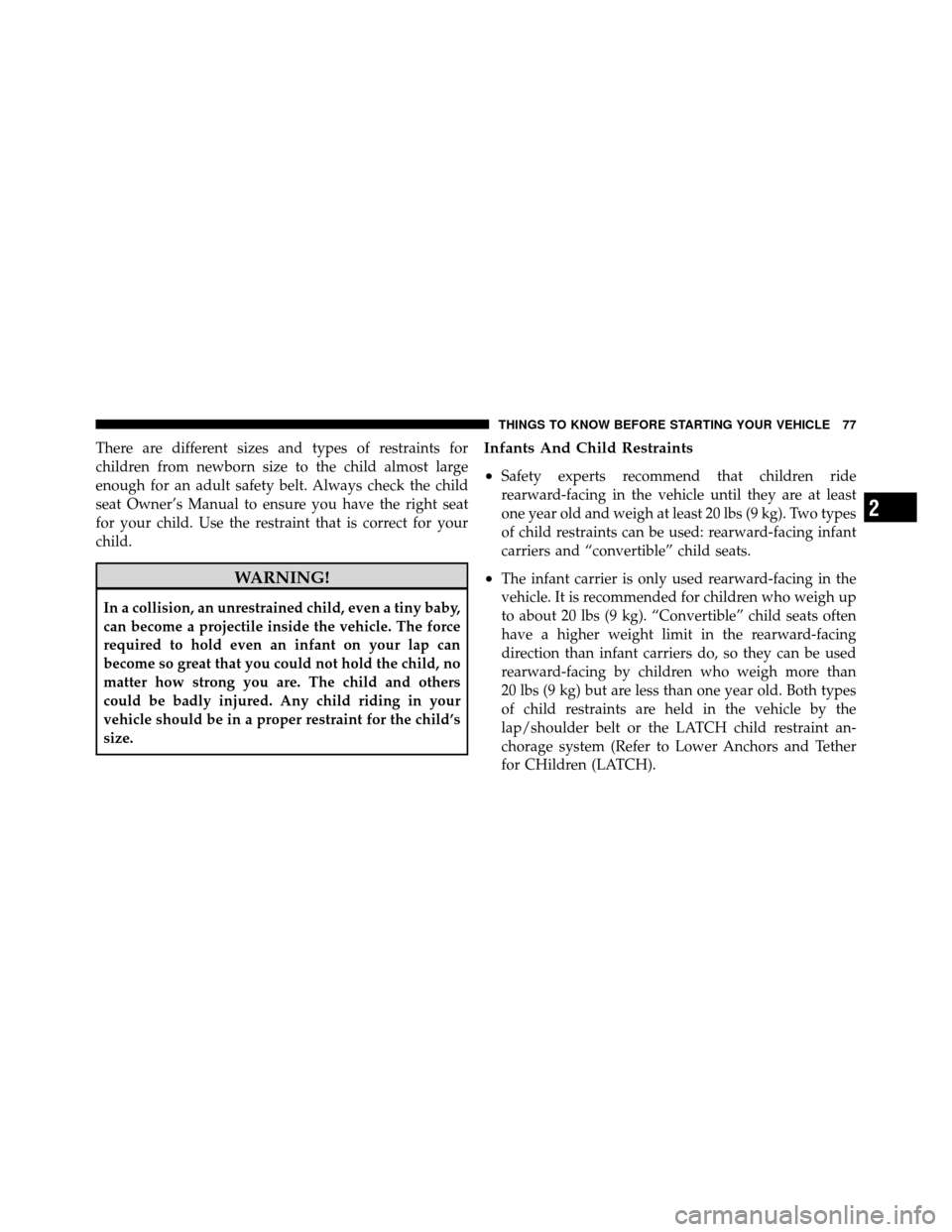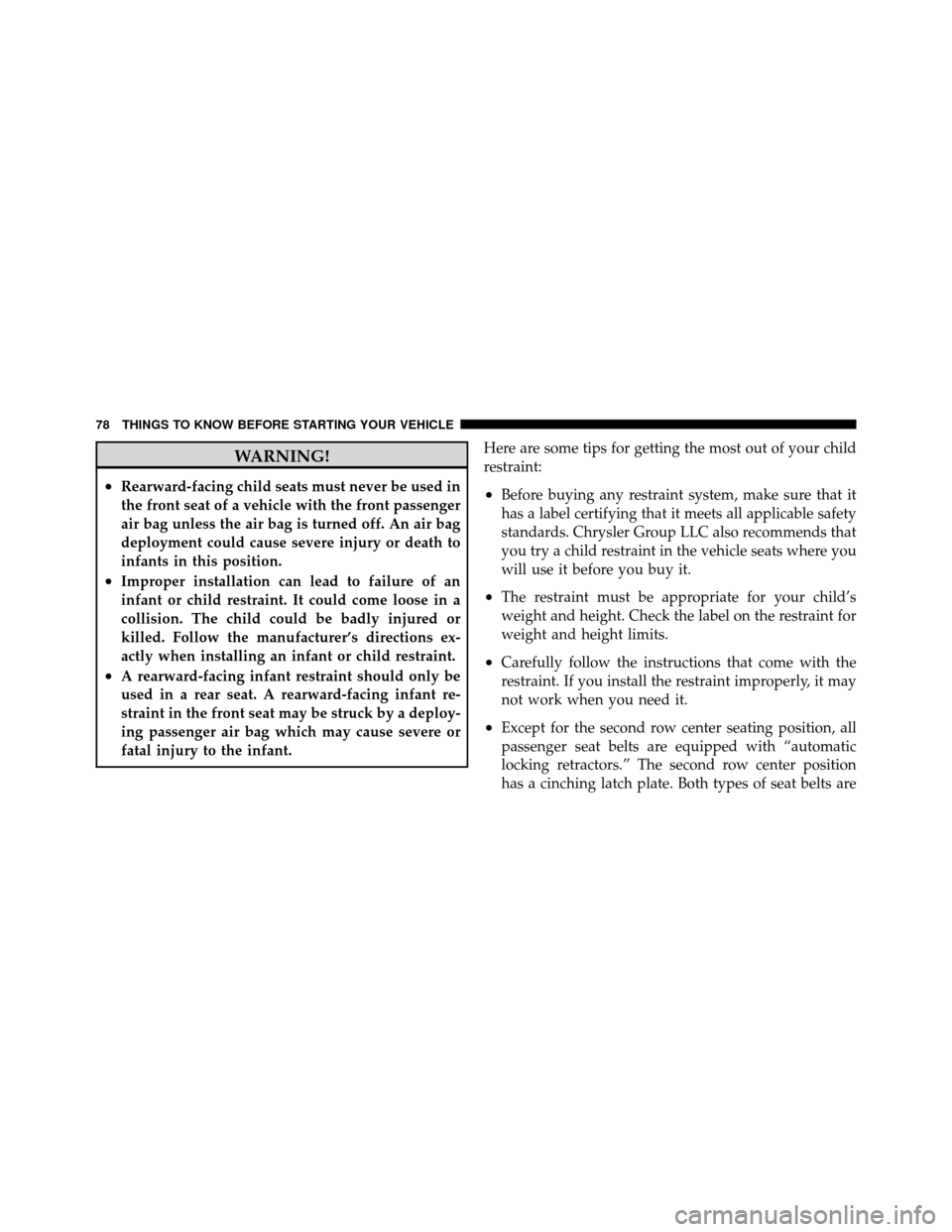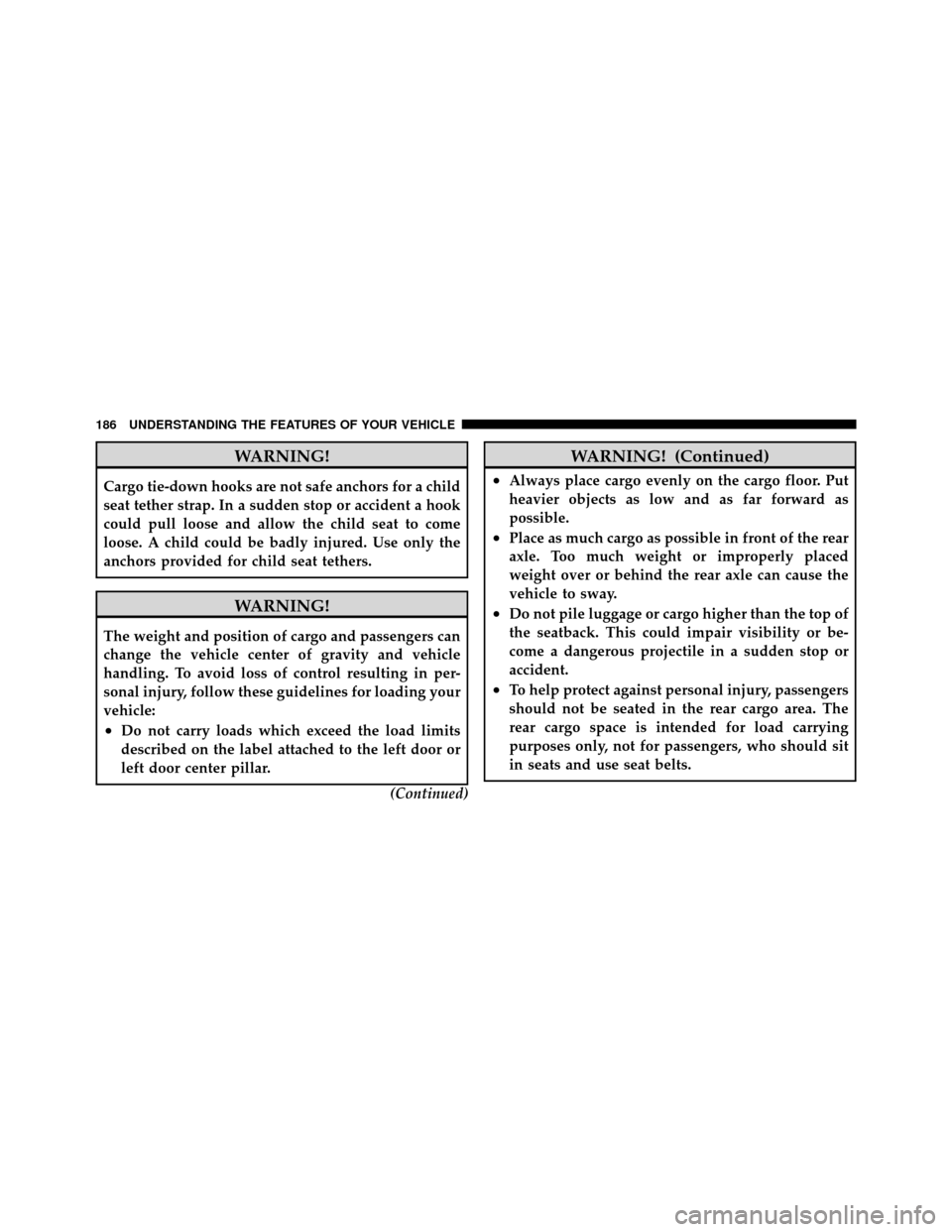2011 DODGE NITRO weight
[x] Cancel search: weightPage 63 of 497

Air Bag System Components
Your vehicle may be equipped with the following air bag
system components:
•Occupant Restraint Controller (ORC)
•Air Bag Warning Light
•Steering Wheel and Column
•Instrument Panel
•Knee Impact Bolster
•Driver Advanced Front Air Bag
•Passenger Advanced Front Air Bag
•Supplemental Side Air Bag Inflatable Curtains
(SABIC)
•Front and Side Impact Sensors
•Front Seat Belt Pretensioners, Seat Belt Buckle Switch,
and Seat Track Position Sensors
•Supplemental Active Head Restraint for Driver and
Front Passenger
•Occupant Classification System (OCS)
•Occupant Classification Module (OCM)
•Passenger Air Bag Disable (PAD) Indicator Light
•Weight Sensors
Advanced Front Air Bag Features
The Advanced Front Air Bag system has multistage
driver and front passenger air bags. This system provides
output appropriate to the severity and type of collision as
determined by the Occupant Restraint Controller (ORC),
which may receive information from the front impact
sensors.
60 THINGS TO KNOW BEFORE STARTING YOUR VEHICLE
Page 69 of 497

WARNING!
Ignoring the Air Bag Warning Light in your instru-
ment panel could mean you won’t have the air bags
to protect you in a collision. If the light does not come
on as a bulb check when the ignition is first turned
on, stays on after you start the vehicle, or if it comes
on as you drive, have an authorized dealer service the
air bag system immediately.
Occupant Classification System (OCS)
The OCS is part of a Federally regulated safety system
required for this vehicle. It is designed to turn off the
passenger Advanced Front Air Bag for an empty seat and
for occupants classified in a category other than an adult.
This could be a child, teenager, or even an adult.
NOTE:Children 12 years or younger should always
ride buckled up in a rear seat in an appropriate child
restraint.
•Occupant Classification Module (OCM)
The OCM is located beneath the front passenger seat. The
OCM classifies the occupant into categories based on the
measurements made by the seat weight sensors. The
OCM communicates with the ORC. The ORC uses the
occupant category to determine whether the passenger
Advanced Front Air Bag should be turned off. It also
determines the rate of air bag inflation during a collision.
•Weight Sensors
Your vehicle has four Weight Sensors located between the
seat and the floor pan. The weight sensors measure
applied weight and transfers that information to the
OCM.
•Passenger Air Bag Disable (PAD) Indicator Light
The PAD Indicator Light (an amber light located in the
center of the instrument panel) tells the driver and front
passenger when the passenger Advanced Front Air Bag is
turned off. The PAD Indicator light illuminates the words
66 THINGS TO KNOW BEFORE STARTING YOUR VEHICLE
Page 71 of 497

WARNING!
Never place a rear facing infant seat in front of an air
bag. A deploying passenger Advanced Front Air Bag
can cause death or serious injury to a child in a
rear-facing infant seat.
Passenger Air Bag Disable (PAD) System
Front Passenger Indicator
Light Air Bag
Status
Adult OFF ON
Child ON OFF
Grocery Bags, Heavy Briefcases and Other
Relatively Light Objects ON OFF
Empty or Very Light Objects OFF* OFF
* Since the system senses weight, some small objects will turn the PAD Indicator Light on. Drivers and adult passengers should verify that the PAD
Indicator Light is not illuminated when an adult is riding
in the front passenger seat. If an adult occupant’s weight
is transferred to another part of the vehicle (like the door
or instrument panel), the weight sensors in the seat may
not properly classify the occupant. Objects lodged under
the seat or between the seat and the center console can
prevent the occupant’s weight from being measured
properly and may result in the occupant being improp-
erly classified. Ensure that the front passenger seatback
does not touch anything placed on the second row of
seats because this can also affect occupant classification.
Also, if you fold down the seats in the second row check
to be sure they don’t touch the front passenger seat.
If the front passenger seat is damaged in any way, it
should only be serviced by an authorized dealer. If the
seat is removed (or even if the seat attachment bolts are
loosened or tightened in any way), take the vehicle to an
authorized dealer.
68 THINGS TO KNOW BEFORE STARTING YOUR VEHICLE
Page 72 of 497

If there is a fault present in the air bag system, the Air Bag
Warning Light (a red light located in the center of the
instrument cluster directly in front of the driver) will be
turned on. This indicates that you should have an autho-
rized dealer service the system immediately. The Air Bag
Warning Light is turned on whenever there is a fault that
can affect the operation of the air bag system. If there is a
fault present in the PAD Indicator Light, the Air Bag
Warning Light will be illuminated to show that the
passenger Advanced Front Air Bag may be turned off
until the fault is cleared. If the Air Bag Warning Light is
illuminated, have an authorized dealer service the air bag
system immediately. If an object is lodged under the seat
and interferes with operation of the weight sensors, a
fault will occur which turns on both the PAD Indicator
Light and the Air Bag Warning Light. Once the lodged
object is removed, the fault will be automatically cleared
after a short period of time.Driver And Passenger Advanced Front Air Bag
Inflator Units
TheDriver And Passenger Advanced Front Air Bag
Inflator Units are located in the center of the steering
wheel and on the right side of the instrument panel.
When the ORC detects a collision requiring the Ad-
vanced Front Air Bags, it signals the inflator units. A large
quantity of non-toxic gas is generated to inflate the
Advanced Front Air Bags. Different air bag inflation rates
are possible based on collision severity and type. The
steering wheel hub trim cover and the upper right side of
the instrument panel separate and fold out of the way as
the air bags inflate to their full size. The air bags fully
inflate in about 50 to 70 milliseconds. This is about half of
the time it takes to blink your eyes. The air bags then
quickly deflate while helping to restrain the driver and
front passenger.
2
THINGS TO KNOW BEFORE STARTING YOUR VEHICLE 69
Page 80 of 497

There are different sizes and types of restraints for
children from newborn size to the child almost large
enough for an adult safety belt. Always check the child
seat Owner’s Manual to ensure you have the right seat
for your child. Use the restraint that is correct for your
child.
WARNING!
In a collision, an unrestrained child, even a tiny baby,
can become a projectile inside the vehicle. The force
required to hold even an infant on your lap can
become so great that you could not hold the child, no
matter how strong you are. The child and others
could be badly injured. Any child riding in your
vehicle should be in a proper restraint for the child’s
size.
Infants And Child Restraints
•
Safety experts recommend that children ride
rearward-facing in the vehicle until they are at least
one year old and weigh at least 20 lbs (9 kg). Two types
of child restraints can be used: rearward-facing infant
carriers and “convertible” child seats.
•The infant carrier is only used rearward-facing in the
vehicle. It is recommended for children who weigh up
to about 20 lbs (9 kg). “Convertible” child seats often
have a higher weight limit in the rearward-facing
direction than infant carriers do, so they can be used
rearward-facing by children who weigh more than
20 lbs (9 kg) but are less than one year old. Both types
of child restraints are held in the vehicle by the
lap/shoulder belt or the LATCH child restraint an-
chorage system (Refer to Lower Anchors and Tether
for CHildren (LATCH).
2
THINGS TO KNOW BEFORE STARTING YOUR VEHICLE 77
Page 81 of 497

WARNING!
•Rearward-facing child seats must never be used in
the front seat of a vehicle with the front passenger
air bag unless the air bag is turned off. An air bag
deployment could cause severe injury or death to
infants in this position.
•Improper installation can lead to failure of an
infant or child restraint. It could come loose in a
collision. The child could be badly injured or
killed. Follow the manufacturer’s directions ex-
actly when installing an infant or child restraint.
•A rearward-facing infant restraint should only be
used in a rear seat. A rearward-facing infant re-
straint in the front seat may be struck by a deploy-
ing passenger air bag which may cause severe or
fatal injury to the infant.Here are some tips for getting the most out of your child
restraint:
•Before buying any restraint system, make sure that it
has a label certifying that it meets all applicable safety
standards. Chrysler Group LLC also recommends that
you try a child restraint in the vehicle seats where you
will use it before you buy it.
•The restraint must be appropriate for your child’s
weight and height. Check the label on the restraint for
weight and height limits.
•Carefully follow the instructions that come with the
restraint. If you install the restraint improperly, it may
not work when you need it.
•Except for the second row center seating position, all
passenger seat belts are equipped with “automatic
locking retractors.” The second row center position
has a cinching latch plate. Both types of seat belts are
78 THINGS TO KNOW BEFORE STARTING YOUR VEHICLE
Page 189 of 497

WARNING!
Cargo tie-down hooks are not safe anchors for a child
seat tether strap. In a sudden stop or accident a hook
could pull loose and allow the child seat to come
loose. A child could be badly injured. Use only the
anchors provided for child seat tethers.
WARNING!
The weight and position of cargo and passengers can
change the vehicle center of gravity and vehicle
handling. To avoid loss of control resulting in per-
sonal injury, follow these guidelines for loading your
vehicle:
•Do not carry loads which exceed the load limits
described on the label attached to the left door or
left door center pillar.(Continued)
WARNING! (Continued)
•Always place cargo evenly on the cargo floor. Put
heavier objects as low and as far forward as
possible.
•Place as much cargo as possible in front of the rear
axle. Too much weight or improperly placed
weight over or behind the rear axle can cause the
vehicle to sway.
•Do not pile luggage or cargo higher than the top of
the seatback. This could impair visibility or be-
come a dangerous projectile in a sudden stop or
accident.
•To help protect against personal injury, passengers
should not be seated in the rear cargo area. The
rear cargo space is intended for load carrying
purposes only, not for passengers, who should sit
in seats and use seat belts.
186 UNDERSTANDING THE FEATURES OF YOUR VEHICLE
Page 223 of 497

•Elapsed Time
•Display Units of Measure in
Press the SCROLL button to cycle through all the trip
computer functions.
The Trip Functions mode displays the following informa-
tion:
•Average Fuel Economy
Shows the average fuel economy since the last reset.
When the fuel economy is reset, the display will read
“RESET” or show dashes for two seconds. Then, the
history information will be erased, and the averaging will
continue from the last fuel average reading before the
reset.
•Distance To Empty (DTE)
Shows the estimated distance that can be traveled with
the fuel remaining in the tank. This estimated distance is
determined by a weighted average of the instantaneous and average fuel economy, according to the current fuel
tank level. DTE cannot be reset through the FUNCTION
SELECT button.
NOTE:
Significant changes in driving style or vehicle
loading will greatly affect the actual drivable distance of
the vehicle, regardless of the DTE displayed value.
When the DTE value is less than 30 miles (48 km)
estimated driving distance, the DTE display will change
to a text display of LOW FUEL. This display will con-
tinue until the vehicle runs out of fuel. Adding a signifi-
cant amount of fuel to the vehicle will turn off the LOW
FUEL text and a new DTE value will display.
•Elapsed Time
Shows the total elapsed time of travel since the last reset
when the ignition switch is in the ACC position. Elapsed
time will increment when the ignition switch is in the ON
or START position.
220 UNDERSTANDING YOUR INSTRUMENT PANEL